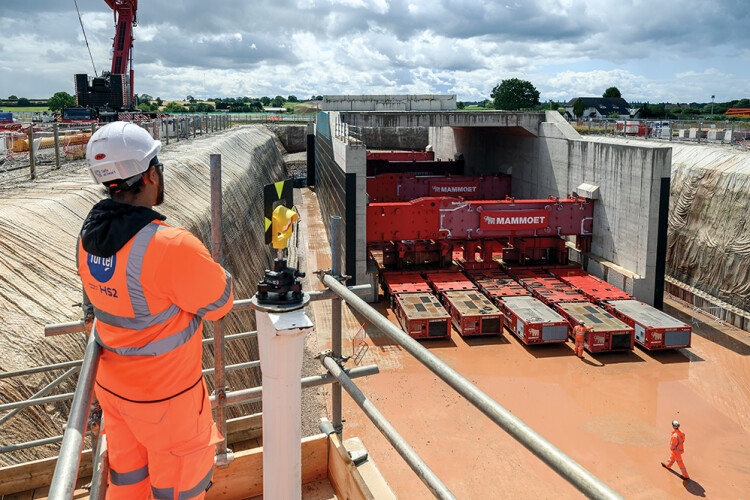Dutch heavy lift specialist Mammoet used an 840-wheeled self-propelled transporter to move a massive concrete box into place on the HS2 project near Lichfield in Staffordshire at the end of July.
The concrete intersection bridge structure, weighing 6,200 tonnes, will allow the new high-speed railway to pass underneath the existing West Coast Mainline (WCML) at Fulfen Wood on its route north from Birmingham to Crewe.
Concrete frame contractor Byrne Brothers, working for main contractor Balfour Beatty Vinci (BBV), built the 56m-long, 19m-wide structure off-line alongside the existing railway over a six-month period prior to its installation this summer.
More than 61,000 cubic metres of earth were removed in preparation for the concrete box to be wheeled into place. Over a two-day period in late July, the construction team dismantled the WCML tracks and excavated a further 15,000 cubic metres of earth to create the space for the structure to sit in.
Mammoet then used its 840-wheeled self-propelled modular transporter (SPMT) to move the 6,200-tonne structure into place.
BBV deployed a team of around 300 people to carry out the civil engineering work, with 200 people on site working around the clock during the installation operation itself.
The operation to move the bridge, backfill around it and put the railway back in place was completed during a nine-day closure of the railway between Stafford and Rugby while Network Rail carried out its own upgrades.
With the work complete, the WCML tracks were replaced and Network Rail reinstalled its railway systems over the new bridge ready for the railway to reopen to passenger and freight services on Monday 24th July.
The operation follows other milestones in the West Midlands including the completion of the one-mile twin-bore tunnel under Long Itchington Wood and the start of production of 3,000 viaduct segments at an outdoor factory in Warwickshire.
HS2 senior project manager Caroline Warrington said: “This huge feat of engineering – the UK’s heaviest single-span bridge drive – is our latest big milestone as we approach peak construction on Phase One of HS2. We’re making fantastic progress on this section of the route.”
BBV section engineer Chloe Foster-Chambers added: “As an engineer, big feats of engineering like this bridge drive make HS2 such a fantastic project to work on. It’s been a real team effort over the last two years, and seeing the operation successfully completed felt like a great achievement for everyone involved.”

Mammoet’s SPMT is a modular system consisting of four, five, six and eight axle lines with a maximum carrying capacity of 44 tonnes per axle line. Each module can be fitted with its own engine, steering and control system and modules can be connected side-by-side and head-to-tail to create a large platform on wheels.
The wheels are all capable of 360o steering, meaning that loads can be moved in any direction and rotated around any point. Deck heights are hydraulically adjustable by 600mm, allowing loads to be lifted and lowered.
Peter Schoenmakers, lead engineer at Stockton-on-Tees-based Mammoet UK, said: “The Fulfen Wood overbridge installation does show that with a collaborative approach and early engagement with all involved parties during the design stage of the structure, a cost-effective and a most efficient installation method can be developed early on in the project.
“The early engagement allowed the designers of the structure to design the bridge that suited the available and existing equipment to be used and no special equipment had to be fabricated or purchased. This approach is very important from a sustainability perspective.”
Just a couple of weeks after the bridge drive at Fulfen Wood, the team was at it again, this time just a mile or so up the line at Streethay where a similar structure – this time a mere 2,600 tonnes – was moved under the South Staffordshire line between Lichfield High Level station and Derby.
For this operation, 14,000 tonnes of earth was excavated to make way for the 25m-long, 18m-wide box to be slid into position under the railway. Once again, the box was built off-line and carried 130m into position by Mammoet’s SPMT.
The Streethay overbridge sits within HS2’s Streethay cutting on the route between Birmingham and Crewe. Structural engineer Mott MacDonald value-engineered the cutting to reduce the total length of retaining wall from 1.6km to just 420m, thereby reducing by 80% the amount of concrete required. HS2 claims that this equates to a saving of 420,000 tonnes of carbon emissions.
“This is a fantastic example of a project within a project at HS2, pulling together teams from 18 specialist supply chain companies from the West Midlands as well as other regions, to deliver a complex construction operation,” said HS2’s Caroline Warrington.
“Unlike the Fulfen Wood bridge structure, which was constructed entirely off-site, the Streethay bridge walls under the railway embankment had to be constructed during the blockade. This required a 72 day blockade, making it more of a marathon than a sprint.”
Got a story? Email news@theconstructionindex.co.uk



